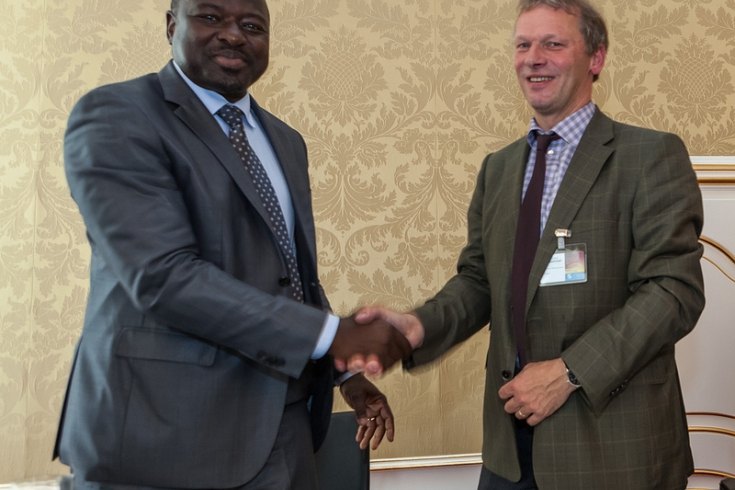Medical Isotope Producers and the CTBTO Join Forces to Reduce Radioxenon Emissions
Emissions are being registered at many locations. And the points of origin are potentially increasing. For the CTBTO, it is not a good trend: “If you have more emissions than you anticipate, then you have a problem,” says Lassina Zerbo, incoming Executive Secretary of the CTBTO and Director of the International Data Centre (IDC).
Certain isotopes of the noble gas xenon – called radioxenon in its radioactive forms – are like the DNA of a nuclear explosion: They provide forensic evidence for analysts. For North Korea's announced nuclear tests over the past seven years, CTBTO teams worked together to track airborne xenon isotopes through the International Monitoring System (IMS – see interactive map). When complete, the IMS will include 40 stations capable of detecting radioxenon. Today it registers about 18,000 samples of xenon a year.
Radionuclide station RN38 at Takasaki, Japan, is one of the stations frequently detecting traces of radioxenon. Click for station profile.
The noble gas background measurement is an important factor. It is one of the important measures that give the nuclear nature of a test.
Xenon Sources Expanding
Monitoring scientists cite an unlikely source for xenon emissions – facilities that produce lifesaving medicines. Radioxenon is a by-product whose releases can be controlled but not curbed entirely during production. The plants make radioactive isotopes used in nuclear medicine worldwide - for more than 30 million diagnostic procedures a year. Production facilities are operated in about 10 countries today, with most producers in Europe, North America and Australia. But production is projected to expand this decade. In Asia, for example, by about 10% a year, says Yudi Imardjamoto, CEO of Indonesia's facility in Serpong.

Medical isotopes play an important role in medicine, for example in diagnostics.
High Stake Challenges
Why are medical sources of radioxenon raising such concerns? They do not pose any health risk, but the readings from these emissions look similar to those of a nuclear explosion. At last week’s CTBT: Science and Technology 2013 conference (SnT2013), a special panel was dedicated to this issue. CTBTO radionuclide expert Mika Nikkinen explained that the impact on IMS stations varies greatly, with up to 400 detections per year at one station and only a single one at others.
For analysts, the picture can get complicated – the ultra-sensitive IMS detects radioxenon from many locations worldwide nearly every day. Stakes are high: multiple civil sources of radioxenon could mask signals from a nuclear explosion. “The job in the IMS to measure for nuclear explosions will become more difficult,” says Ted Bowyer, Manager of the Nuclear Explosion Monitoring & Policy Program at the USA's Pacific Northwest National Laboratory (PNNL), who spoke of “fogs of xenon over North America and Europe.”

Panel members, from left: Mika Nikkinen, Meera Venkatesh, Jean-Michel Vanderhofstadt, Ian Hoffman (Moderator), Anders Ringbom and Ted Bowyer (click to enlarge)
Xenon releases from medical isotope facilities can look very similar to releases from a nuclear explosion. That's because the isotopic composition is very similar in both cases.
Twin Goals
To meet the xenon challenge, global efforts target twin goals: improved xenon monitoring and lower emissions. Increasingly producers are looking at different methods to achieve reductions.
In an important development last week, the Belgium-based Institute for Radioelements (IRE) signed a pledge to cooperate with the CTBTO to mitigate the effects of noble gas emissions. The IRE is a major worldwide producer of radioelements used for diagnoses and therapeutics in nuclear medicine.
Lassina Zerbo and Jean-Michel Vanderhofstadt, Managing Director of the IRE, signed a pledge to cooperate to mitigate xenon emissions for test-ban verification. For the IRE, it’s a noble cause. Its cooperation is voluntary and will help the world’s nuclear test-ban monitors to focus on detecting atomic explosions.

CTBTO Executive Secretary-elect Lassina Zerbo (left) and Jean-Michel Vanderhofstadt, Managing Director, Institute for Radioelements (IRE) signed a pledge on co-operation between IRE and CTBTO in noble gas mitigation.
We are pleased to cooperate on mitigating xenon emissions with the CTBTO, while keeping our focus on health care for the around 6 million patients who receive our products each year.

Johan Camps (centre) of the Belgian Nuclear Research Centre was awarded the EU Star Award for excellence in verification science by Ambassador Györgyi Martin Zanathy (right), Head of the Delegation of the European Union to the International Organizations in Vienna, and Lassina Zerbo (left).

Inside Indonesia's Serpong medical isotope production facility.
Sustained Global Collaboration
Leaders from the world's largest producers of medical isotopes, such as the IRE, increasingly support CTBTO initiatives. Joint work seeks to establish a voluntary threshold for xenon emissions, and to improve scientific understanding of background levels in the air.
Ultimately, cooperation helps achieve bigger goals. “Our prime responsibility is verifying the Test-Ban Treaty and it is all about collaboration,” says Lassina Zerbo. “The noble gas background measurement is an important factor. It is one of the important measures that give the nuclear nature of a test.”
A new video highlights how multiple sources of radioxenon challenge the world's monitoring of nuclear testing:

The noble gas detection system installed on the rooftop of the Vienna International Centre.
27 Jun 2013
